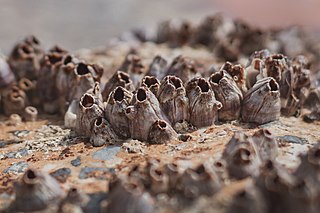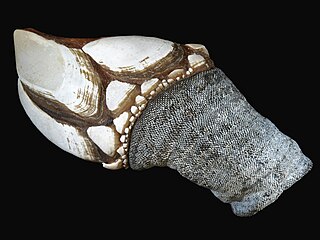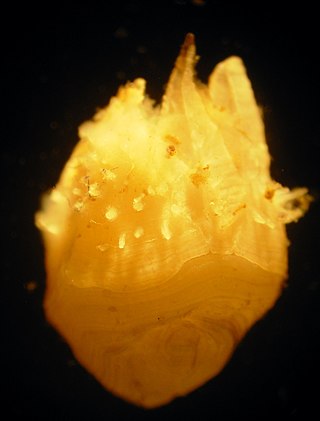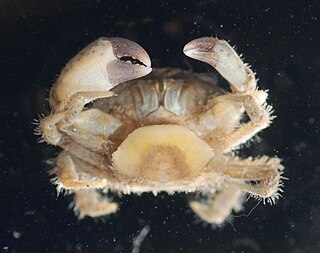
Balanus is a genus of barnacles in the family Balanidae of the subphylum Crustacea.

Thecostraca is a class of marine invertebrates containing over 2,200 described species. Many species have planktonic larvae which become sessile or parasitic as adults.

The Balanidae comprise a family of barnacles of the order Balanomorpha. As a result of research published in 2021 by Chan et al., the members of the family Archaeobalanidae were merged with this family.

Pollicipes pollicipes, known as the goose neck barnacle, goose barnacle or leaf barnacle is a species of goose barnacle, also well known under the taxonomic synonym Pollicipes cornucopia. It is closely related to Pollicipes polymerus, a species with the same common names, but found on the Pacific coast of North America, and to Pollicipes elegans a species from the coast of Chile. It is found on rocky shores in the north-east Atlantic Ocean and is prized as a delicacy, especially in the Iberian Peninsula.

Acasta is a genus of barnacles in the family Balanidae, containing the following species:

Pollicipes is a genus of goose barnacles, first described by William Elford Leach in 1817. It comprises four species of marine suspension-feeders.

Chelonibia is a genus of acorn barnacles in the family Chelonibiidae of the subphylum Crustacea. Its members are epizootic and live attached to manatees, turtles, marine molluscs, crabs and horseshoe crabs in all tropical and subtropical oceans. In a few instances, they have been found on sea snakes, alligators and inanimate substrates, but they are not found in the typical habitats of barnacles – on rocks, docks or boats.
Dipterosaccus is a genus of barnacle.
Conopea is a genus of barnacle, containing the following species:
The Catophragmidae are a family of barnacles in the superfamily Chthamaloidea with eight shell wall plates, surrounded by several whorls of imbricating plates. The basis is membranous.

Chelonibia testudinaria is a species of barnacle in the family Chelonibiidae. It is native to the Atlantic Ocean, Mediterranean Sea and Gulf of Mexico where it lives as a symbiont on sea turtles, being particularly abundant on the loggerhead sea turtle.

Poecilasmatidae is a family of goose barnacles.
Oxynaspididae is a family of goose barnacles in the order Lepadiformes.
Oxynaspis gracilis is a species of goose barnacle in the family Oxynaspididae, commonly known as the black coral barnacle because it is normally found attached to black coral. The type specimen was found in Réunion in the East Indies.

Pollicipes caboverdensis is a species of goose barnacle in the family Pollicipedidae. It is found in rocky intertidal zones on the coasts of the islands Santiago, Sal and São Vicente, Cape Verde. The species was first described by Joana N. Fernandes, Teresa Cruz and Robert Van Syoc in 2010 after a 24.5 mm specimen collected from Ponta Preta, northwestern Santiago.
Iblomorpha is a small order of barnacles in the class Thecostraca. There are only two families and about eight described species in Iblomorpha. In this group we find barnacles that use calcium phosphate in their shell, and species that protect themselves against predators with poison.

Microeuraphia is a genus of star barnacles in the family Chthamalidae. There are about eight described species in Microeuraphia.

Pachylasma is a genus of symmetrical sessile barnacles in the family Pachylasmatidae. There are about eight described species in Pachylasma.

Loxothylacus is a genus of parasitic barnacles in the family Sacculinidae. There are more than 20 described species in Loxothylacus.

Waikalasma is a genus of symmetrical sessile barnacles in the family Waikalasmatidae, the sole genus of the family. There are at least three described species in Waikalasma.












